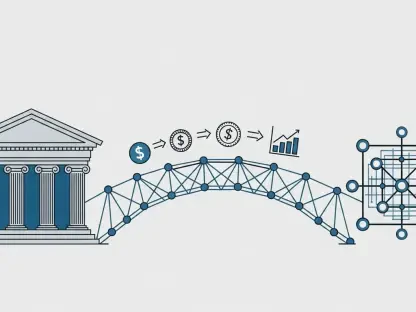In an era where financial systems are racing to keep pace with technological innovation, a staggering $303 billion stablecoin market signals a seismic shift in global payments, highlighting the urgency for traditional institutions to adapt. Nine of the world’s most influential banks, including Goldman Sachs, Deutsche Bank, Bank of America, and Banco Santander, alongside BNP Paribas, Citigroup, MUFG Bank, TD Bank Group, and UBS Group, have united to launch a blockchain-based digital currency. This bold coalition aims to integrate cryptocurrency infrastructure into mainstream payment networks, focusing on a 1:1 reserve-backed digital asset tied to G7 currencies. The move not only underscores the growing acceptance of blockchain technology but also positions these institutions at the forefront of a transformative market trend. This analysis dives deep into the forces driving this initiative, examines current market dynamics, and projects the potential impact on the financial landscape, offering critical insights for stakeholders navigating this evolving space.
Market Momentum: Blockchain’s Ascent in Financial Systems
The financial sector is witnessing an unprecedented pivot as blockchain technology moves from a speculative novelty to a cornerstone of modern banking. Initially met with caution due to its ties to volatile cryptocurrencies, blockchain has gained traction over recent years for its ability to deliver secure, transparent, and rapid transaction processing. Stablecoins, pegged to fiat currencies like the US dollar or euro, have emerged as a game-changer, mitigating volatility concerns and enabling instant settlements. With the global stablecoin circulation supply reaching $303 billion as of this year, the market reflects a nearly $100 billion surge in just 12 months, highlighting robust demand from both corporate entities and financial institutions.
This growth is not merely a numerical milestone but a signal of broader adoption across industries. Banks are increasingly recognizing blockchain’s potential to slash transaction costs—by as much as 80% compared to legacy systems—while enhancing liquidity management. The collaborative effort of these nine banking giants to develop a reserve-backed digital currency on public blockchains represents a strategic alignment with market needs for efficiency and scalability. However, challenges such as ensuring reserve transparency and managing systemic risks linger, underscoring the need for rigorous oversight as this technology scales.
Transitioning from historical skepticism to current enthusiasm, the market’s trajectory suggests a maturing ecosystem. Pilot projects and fintech partnerships over recent years have laid the groundwork, proving blockchain’s viability for cross-border payments and interbank settlements. As this analysis unfolds, the focus shifts to the specific catalysts propelling this digital currency initiative and their implications for market dynamics.
Diving Deep: Key Catalysts Shaping the Digital Currency Market
Stablecoins as Market Stabilizers
At the heart of this financial revolution lies the explosive rise of stablecoins, which have become indispensable for efficient transaction processing. Unlike traditional cryptocurrencies prone to wild price swings, stablecoins maintain value stability through fiat reserves, making them ideal for real-time settlements and operational streamlining. Their market dominance is evident in the $303 billion circulation supply, a figure that reflects growing corporate trust in their utility beyond crypto trading, extending to payroll, supply chain financing, and more.
Yet, the rapid expansion of stablecoins is not without hurdles. Concerns over the adequacy and transparency of reserve backing pose potential risks to market confidence, while the possibility of systemic disruptions if large-scale redemptions occur cannot be ignored. The coalition of major banks addresses these issues by prioritizing robust reserve mechanisms and regulatory compliance, aiming to set a benchmark for stability. This strategic focus could further solidify stablecoins as a trusted asset class, driving even greater market penetration in the coming years.
Regulatory Frameworks as Growth Accelerators
Beyond technological advancements, regulatory clarity has emerged as a powerful driver of market confidence in blockchain-based currencies. A pivotal development came earlier this year with the enactment of the Genius Act in the US, a legislative milestone that provides clear guidelines for reserve-backed digital assets and encourages institutional engagement. This policy shift has created a fertile ground for banks to innovate without the overhang of legal ambiguity, spurring investment and collaboration across the sector.
In parallel, Europe is carving its own path with a concerted effort by nine banks, including ING and UniCredit, to introduce a euro-denominated stablecoin under the EU’s Markets in Crypto-Assets (MiCAR) framework, targeting a rollout by 2026. This initiative reflects a broader ambition to challenge dollar dominance in global finance while adhering to stringent regional standards. Although such regulatory tailwinds are promising, the risk of fragmented international policies could create uneven market conditions, necessitating harmonized global standards to sustain growth.
Regional Dynamics and Market Differentiation
Market adoption of blockchain currencies also reveals striking regional variations, each shaped by local economic priorities and regulatory landscapes. In the US, North Dakota’s innovative “Roughrider Coin,” a state-backed stablecoin for interbank and local business transactions, exemplifies how localized efforts can influence national trends. This pioneering project highlights a bottom-up approach to integrating digital assets into everyday finance, potentially inspiring other states to follow suit.
Contrastingly, Europe’s strategy leans toward collective action, with the euro stablecoin project aiming to bolster regional financial autonomy and reduce reliance on external systems. These differing approaches, while rooted in distinct cultural and political contexts, converge on a shared objective of enhancing transactional efficiency. Market analysts anticipate that reconciling these diverse strategies will be crucial to avoiding operational silos, ensuring that global interoperability remains a priority as adoption accelerates from 2025 to 2027.
Projections: Blockchain’s Role in Reshaping Financial Markets
Looking ahead, the market for blockchain-based digital currencies appears set for exponential growth, with stablecoins likely to become deeply embedded in mainstream financial systems. Emerging technologies, such as faster public blockchains and smart contract automation, are expected to further reduce transaction latencies and operational costs, making digital currencies even more attractive to institutions. Industry forecasts suggest that by 2030, blockchain-driven payments could account for over 20% of global transactions, fueled by increasing institutional buy-in and technological refinement.
Economic trends, particularly the rising demand for seamless cross-border solutions, are poised to amplify this shift. As businesses globalize, the need for cost-effective, instantaneous payment mechanisms will drive further investment in blockchain infrastructure. Regulatory efforts to standardize frameworks across borders could mitigate current risks of fragmentation, creating a more cohesive market environment. While speculative, these projections indicate a future where digital currencies rival traditional money in ubiquity, fundamentally altering the financial services landscape.
Reflecting on Market Shifts and Strategic Pathways
Looking back, the unified push by nine leading banks to launch a blockchain-based digital currency marked a historic turning point for the financial sector. The rapid expansion of the stablecoin market to $303 billion, coupled with regulatory breakthroughs like the Genius Act and regional innovations such as the euro stablecoin initiative and Roughrider Coin, underscored a powerful momentum toward digital integration. These developments highlighted a strategic realignment of financial infrastructure to prioritize speed and accessibility.
For stakeholders, the path forward demands proactive engagement with this evolving landscape. Businesses need to invest in blockchain capabilities and forge partnerships to remain competitive in a digital-first economy. Financial professionals are urged to deepen their understanding of stablecoin mechanisms and regulatory nuances to navigate emerging opportunities. Meanwhile, policymakers face the challenge of balancing innovation with stability, crafting frameworks that foster growth without compromising systemic security. These actionable steps pave the way for harnessing the full potential of blockchain technology in reshaping global finance.









